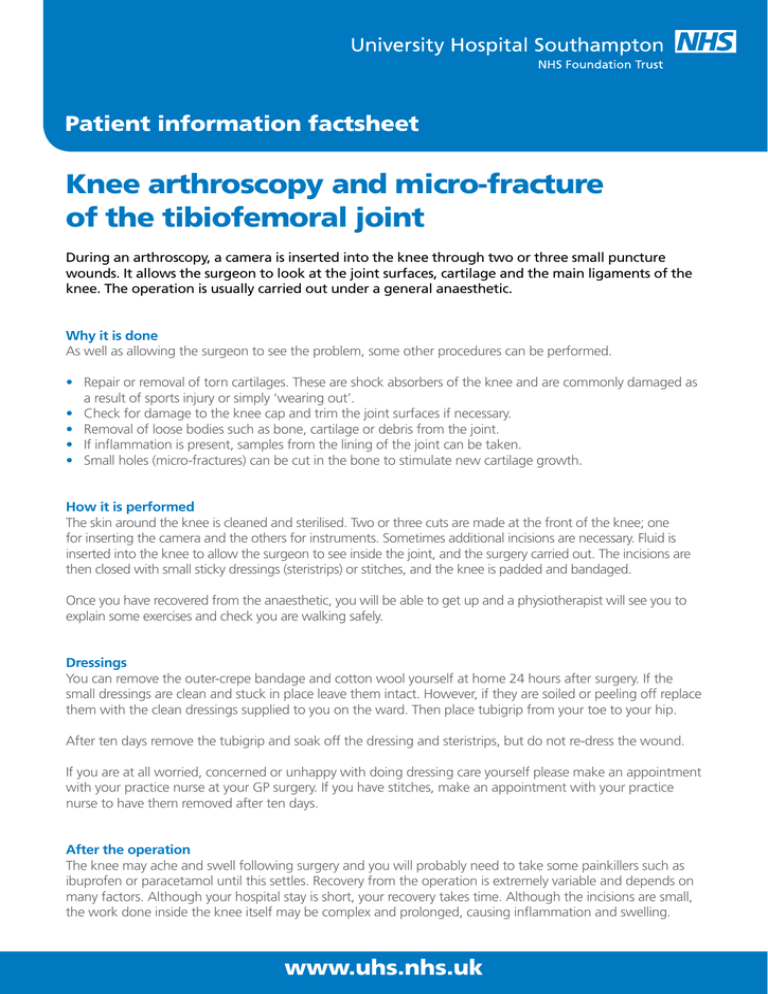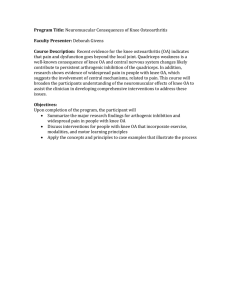Knee arthroscopy and micro-fracture of the tibiofemoral joint
advertisement

Patient information factsheet Knee arthroscopy and micro-fracture of the tibiofemoral joint During an arthroscopy, a camera is inserted into the knee through two or three small puncture wounds. It allows the surgeon to look at the joint surfaces, cartilage and the main ligaments of the knee. The operation is usually carried out under a general anaesthetic. Why it is done As well as allowing the surgeon to see the problem, some other procedures can be performed. • • • • • Repair or removal of torn cartilages. These are shock absorbers of the knee and are commonly damaged as a result of sports injury or simply ‘wearing out’. Check for damage to the knee cap and trim the joint surfaces if necessary. Removal of loose bodies such as bone, cartilage or debris from the joint. If inflammation is present, samples from the lining of the joint can be taken. Small holes (micro-fractures) can be cut in the bone to stimulate new cartilage growth. How it is performed The skin around the knee is cleaned and sterilised. Two or three cuts are made at the front of the knee; one for inserting the camera and the others for instruments. Sometimes additional incisions are necessary. Fluid is inserted into the knee to allow the surgeon to see inside the joint, and the surgery carried out. The incisions are then closed with small sticky dressings (steristrips) or stitches, and the knee is padded and bandaged. Once you have recovered from the anaesthetic, you will be able to get up and a physiotherapist will see you to explain some exercises and check you are walking safely. Dressings You can remove the outer-crepe bandage and cotton wool yourself at home 24 hours after surgery. If the small dressings are clean and stuck in place leave them intact. However, if they are soiled or peeling off replace them with the clean dressings supplied to you on the ward. Then place tubigrip from your toe to your hip. After ten days remove the tubigrip and soak off the dressing and steristrips, but do not re-dress the wound. If you are at all worried, concerned or unhappy with doing dressing care yourself please make an appointment with your practice nurse at your GP surgery. If you have stitches, make an appointment with your practice nurse to have them removed after ten days. After the operation The knee may ache and swell following surgery and you will probably need to take some painkillers such as ibuprofen or paracetamol until this settles. Recovery from the operation is extremely variable and depends on many factors. Although your hospital stay is short, your recovery takes time. Although the incisions are small, the work done inside the knee itself may be complex and prolonged, causing inflammation and swelling. www.uhs.nhs.uk Patient information factsheet There is often a leakage of clear fluid from the knee through the incisions in the first few days until the wound is healed. This can take several days to settle. Physiotherapy It is important to follow the instructions and exercises given to you in hospital by the physiotherapist. You will be taught to use crutches to help you walk, and be advised how much weight you can put through your operated leg. An outpatient physiotherapy appointment will be arranged for you once you are at home. Ice packs such as a bag of frozen peas wrapped in a towel will help to reduce swelling and can be applied, if needed, every hour for 15-20 minutes. Working The majority of patients should be able to return to normal daily activities and sedentary (office-type) work once they are allowed to fully weight bear on the operated leg and walking without undue pain; this may take up to six weeks. If your job is more physical and involves climbing, squatting or lots of stairs, you may need up to three months off to recover, to allow pain, muscle strength and swelling to settle. The small incisions may well be tender and lumpy and your knee may swell after activity for up to three months. If required, you can be issued with an off-work certificate for two weeks before you leave hospital. If you need a certificate for longer consult your GP. Driving Driving may be possible after six weeks if your knee is feeling comfortable. Make sure you can bend and straighten your knee without excessive pain. Check that you can perform an emergency stop safely. You should check with your car insurance company or physiotherapist if you are concerned. Sport Strenuous physical activity can be resumed when your knee is feeling strong and comfortable and no longer swollen; this is usually after three months. It is advisable to gradually increase your level of activity to see how your knee copes. It may take longer before returning to competitive sport such as running, skiing, racquet and contact sports. Make sure you can hop, squat and sprint with changes of direction and make sudden stops and starts without pain. Complications Although uncommon, complications can occur following your surgery. These include: • excessive bleeding from the wounds or soaking the dressing after the operation • excessive swelling • deep vein thrombosis (clot in the lower leg veins) •infection. If you are concerned in any way, please contact the nursing staff on the ward or your GP for advice. If you develop a fever, severe pain or significant wound problems, you will need to see someone as soon as possible. www.uhs.nhs.uk Patient information factsheet Exercises following knee arthroscopy and micro-fracture of the tibiofemoral joint Try to complete the exercises at least three times a day. Keep your leg elevated to decrease swelling. Apply ice, wrapped in a pillowcase or tea towel, to your knee for ten minutes every hour. 1. Lie on your back and bend and straighten your leg, sliding your heel towards your bottom. Repeat 15 times. 2. Lie on your back and pull your toes towards you, bracing your knees down firmly against the bed. Hold for ten seconds and repeat 20 times. 3. Lie on your back and place a rolled up blanket underneath your knee. Push your knee down into the blanket and lift your heel off the bed. Hold for ten seconds and repeat 15 times. 4. Sit down, bending your knee as much as possible and then straighten it. Repeat 15 times. 5. Lie on your back with your toes pulled towards you and tighten the muscles on the front of your thigh to straighten your knee. Lift the leg off the bed by approximately 20 cm. Repeat ten times. 6. Sit with your foot resting on a coffee table, so the knee is unsupported. Let your leg straighten as much as possible. Rest in this position for five minutes. www.uhs.nhs.uk Patient information factsheet 7. Stand holding onto a supportive surface, bend one knee and take hold of your ankle. Draw your heel towards your buttock and push your hip forwards so that your knee points to the floor. Feel the stretch in the front of your thigh. Hold for 30 seconds and repeat three times. 8. Lie on your back with your leg up, keeping your knee as straight as possible until you feel a stretch in the back of your leg. Maintain this position by supporting your leg with your hands behind your thigh. Hold for 30 seconds and repeat three times. 9. Stand holding onto a supportive surface and stretch one leg behind you, keeping your knee straight and your foot flat on the floor. Gently lean forwards until you feel a stretch in your calf muscle. Hold for 30 seconds and repeat three times. Contact details Orthopaedic physiotherapy team Southampton General Hospital Tremona Road Southampton SO16 6YD Tel: 023 8079 4452 If you need a translation of this document, an interpreter or a version in large print, Braille or on audio tape, please telephone 023 8079 4688 for help. Revised Sept 12 Review date Sept 2015. THY 001.36 www.uhs.nhs.uk


